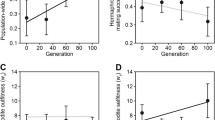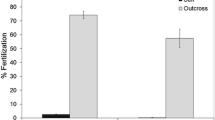Abstract
Androdioecy (populations comprised of mixtures of males and hermaphrodites) is a rare mating system, found only in a few plants and animals. The rarity of this system stems from the limited benefits to males in an otherwise all-hermaphroditic population. One of the potential benefits to males is typified by the nematode Caenorhabditis elegans, in which hermaphrodites do not produce sufficient sperm to fertilize all of their eggs. Here we explore the possibility that males are needed for complete fertilization of hermaphrodites' eggs in a second androdioecious animal, the clam shrimp Eulimnadia texana. We compare the fertilization rate of outcrossed to selfed eggs to test whether the latter exhibit lower fertilization due to sperm limitation (as in C. elegans). Because this comparison confounds differences in egg fertilization due to sperm limitation with the potential for early inbreeding depression, we also used a third mating treatment, a brother/sister cross, to allow separation of sperm limitation from inbreeding depression. In both populations examined, the proportion of eggs that were fertilized decreased linearly with increasing relatedness: comparing eggs produced by outcrossing, brother/sister, and selfed matings, respectively. This pattern suggests that differences in fertilization among these three treatments were caused solely by inbreeding depression, and therefore that hermaphrodites are not sperm limited. These results are combined with previous data on this species to test whether the maintenance of males can be explained using a population genetics model specifically designed for this species.
Similar content being viewed by others
References
Aronne, G. and Wilcock, C.C. (1994) Reproductive characteristics and breeding system of shrubs in the Mediterranean region. Func. Ecol. 8, 69-76.
Belk, D. (1987) Embryonic cuticles of Artemia during diapause and hatching: Insights from comparison with other branchiopoda. J. Crust. Biol. 7, 691-696.
Charlesworth, D. (1984) Androdioecy and the evolution of dioecy. Biol. J. Linn. Soc. 23, 33-348.
Charlesworth, B., Morgan, M.T. and Charlesworth, D. (1991) Mulitlocus models of inbreeding depression with synergistic selection and partial self-fertilization. Gen. Res. 57, 177-194.
Dudash, M.R. (1990) Relative fitness of selfed and outcrossed progeny in a self-compatible, protandrous species, Sabatia angularis L. (Gentianaceae): a comparison in three environments. Evolution 44, 1129-1139.
Falconer, D.S. (1981) Introduction to Quantitative Genetics. 2nd edn. Longman, London, 340 pp.
Fryer, G. (1987) A new classification of the branchiopod crustacea. J. Linn. Soc. Lond. Zool. 91, 357-383.
Hodgkin, J. (1983) Male phenotypes and mating efficiency in Caenorhabditis elegans. Genetics 103, 43-64.
Hodgkin, J. and Barnes, T.M. (1991) More is not better. Brood size and population growth in a self-fertilizing nematode. Proc. R. Soc. Lond. B 246, 19-24.
Hollenbeck, V.G. (1998) The effects of social conditions and mating behavior on the maintenance of androdioecy in the freshwater shrimp Eulimnadia texana, Master's Thesis, Department of Biology, New Mexico State University, Las Cruces, 42 pp.
Hollenbeck, V.G., Weeks, S.C., Gould, W. and Zucker, N. Maintenance of androdioecy in the freshwater shrimp Eulimnadia texana: Sexual encounter rates and outcrossing success. Behav. Ecol. (in press).
Husband, B.C. and Schemske, D.W. (1996) Evolution of the magnitude and timing of inbreeding depression in plants. Evolution 50, 54-70.
Hutchison, J.A. (1999) Fertilization rates in two populations of the androdioecious ephemeral pond crustacean, Eulimnadia texana, Master's Thesis, Department of Biology, The University of Akron, 47 pp.
Kimble, J. and Ward, S. (1988) Germ-line development and fertilization. In W.B. Wood (ed.) The Nematode Caenorhabditis elegans. Cold Spring Harbor Laboratory Press, NY, USA, pp. 191-213.
LaMunyon, C.W. and Ward, S. (1995) Sperm precedence in a hermaphroditic nematode (Caenorhabditis elegans) is due to competitive superiority of male sperm. Experientia 51, 817-823.
LaMunyon, C.W. and Ward, S. (1998) Larger sperm outcompete smaller sperm in the nematode Caenorhabditis elegans. Proc. R. Soc. Lond. B 265, 1997-2002.
Lande, R. and Schemske, D.W. (1985) The evolution of self-fertilization and inbreeding depression in plants. I. Genetic models. Evolution 39, 24-40.
Lepart, J. and Dommee, B. (1992) Is Phillyrea angustifolia L. (Oleaceae) an androdioecious species? Bot. J. Linn. Soc. 108, 375-387.
Liston, A., Rieseberg, L.H. and Elias, T.S. (1990) Functional androdioecy in the flowering plant Datisca glomerata. Nature 343, 641-642.
Lloyd, D.G. (1975) The maintenance of gynodioecy and androdioecy in angiosperms. Genetica 45, 325-339.
McLaughlin, P.A. and Henry, D.P. (1972) Comparative morphology of complemental males in four species of Balanus. Crustaceana 22, 13-30.
Medland, V.L., Zucker, N. and Weeks, S.C. (2000) Implications for the maintenance of androdioecy in the freshwater shrimp, Eulimnadia Texana Packard: Encounters between males and hermaphrodites are not random. Ethology 106, 839-848.
Molau, U. and Prentice, H.C. (1992) Reproductive system and population structure in three arctic Saxifraga species. J. Ecol. 80, 149-161.
Newman, W.A., Zullo, V.A. and Withers, T.H. (1969) Cirripedia. In R.C. Moore (ed.) Treatise on Invertebrate Paleontology. Part R. Arthropoda 4, Geological Society of America and University of Kansas Press, Lawrence, Kansas, USA, pp. 206-295.
Otto, S.P., Sassaman, C. and Feldman, M.W. (1993) Evolution of sex determination in the conchostracan shrimp Eulimnadia texana. Am. Nat. 141, 329-337.
Pannell, J. (1997a) Widespread functional androdioecy in Mercurialis annua L. (Euphorbiaceae). Biol. J. Linn. Soc. 61, 95-116.
Pannell, J. (1997b) The maintenance of gynodioecy and androdioecy in a metapopulation. Evolution 51, 10-20.
Ramsey, M. and Vaughton, G. (1998) Effect of environment on the magnitude of inbreeding depression in seed germination in a partially self-fertile perennial herb (Blandfordia grandiflora, Liliaceae). Int. J. Plant Sci. 159, 98-104.
SAS Institute Inc. (1997) JMP Statistical Software, SAS Institute Inc., Cary, North Carolina.
Sassaman, C. (1989) Inbreeding and sex ratio variation in female-biased populations of a clam shrimp, Eulimnadia texana. Bull. Mar. Sci. 45, 425-432.
Sassaman, C. (1991) Sex ratio variation in female-biased populations of Notostracans. Hydrobiologia 212, 169-179.
Sassaman, C. and Weeks, S.C. (1993) The genetic mechanism of sex determination in the conchostracan shrimp Eulimnadia texana. Am. Nat. 141, 314-328.
Schemske, D. (1983) Breeding system and habitat effects on fitness components in three neotropical Costas (Zingiberaceae). Evolution 37, 523-539.
Spears, T. and Abele, L.G. (2000) Branchiopod monophyly and interordinal phylogeny inferred from 18S ribosomal DNA. J. Crust. Biol. 20, 1-24.
Turner, B.J., Davis, W.P. and Taylor, D.S. (1992) Abundant males in populations of a selfing hermaphrodite fish, Rivulus marmoratus, from some Belize cays. J. Fish Biol. 40, 307-310.
Ward, S. and Carrel, J.S. (1979) Fertilization and sperm competition in the nematode Caenorhabditis elegans. Dev. Biol. 73, 304-321.
Weeks, S.C. and Zucker, N. (1999) Inbreeding rates in the androdioecious crustacean, Eulimnadia texana. Can. J. Zool. 77, 1402-1408.
Weeks, S.C., Marcus, V. and Alvarez, S. (1997) Notes on the life history of the clam shrimp, Eulimnadia texana. Hydrobiologia 359, 191-197.
Weeks, S.C., Marcus, V. and Crosser, B. (1999) Inbreeding depression in a self-compatible, androdioecious crustacean, Eulimnadia texana. Evolution 53, 472-483.
Weeks, S.C., Crosser B.R., Bennett, R., Gray, M. and Zucker, N. (2000a) Maintenance of androdioecy in the freshwater shrimp, Eulimnadia texana: Estimates of inbreeding depression in two populations. Evolution 54, 878-887.
Weeks, S.C., Crosser B.R., Gray, M.M., Matweyou, J.A. and Zucker, N. (2000b) Is there sperm storage in the clam shrimp Eulimnadia texana? Invert. Bio. 119, 215-221.
Weeks, S.C., Crosser B.R., and Gray, M.M. (2001) Relative fitness of two hermaphroditic mating types in the androdioecious clam shrimp, Eulimnadia texana. J. Evol. Biol. 14, 83-94.
Willis, J.H. (1993) Effects of different levels of inbreeding on fitness components in Mimulus guttatus. Evolution 47, 864-876.
Wood, W.B. (1988) The Nematode Caenorhabditis elegans. Cold Spring Harbor Laboratory, Cold Spring Harbor, NY, USA, 667 pp.
Wright, S. (1977) Evolution and the Genetics of Populations, vol. 3. Experimental Results and Evolutionary Deductions. University of Chicago Press, Chicago, IL, USA, 611 pp.
Zucker, N., Stafki, B. and Weeks, S.C. (2001) Maintenance of androdioecy in the freshwater shrimp, Eulimnadia texana: relative longevity of males to hermaphrodites. Can. J. Zool. 79, 393-401.
Zucker, N., Cunningham, M. and Adams, H.P. (1997) Anatomical evidence for androdioecy in the clam shrimp Eulimnadia texana. Hydrobiologia 359, 171-175.
Author information
Authors and Affiliations
Rights and permissions
About this article
Cite this article
Weeks, S.C., Hutchison, J.A. & Zucker, N. Maintenance of androdioecy in the freshwater shrimp, Eulimnadia texana: do hermaphrodites need males for complete fertilization?. Evolutionary Ecology 15, 205–221 (2001). https://doi.org/10.1023/A:1014878521117
Issue Date:
DOI: https://doi.org/10.1023/A:1014878521117




